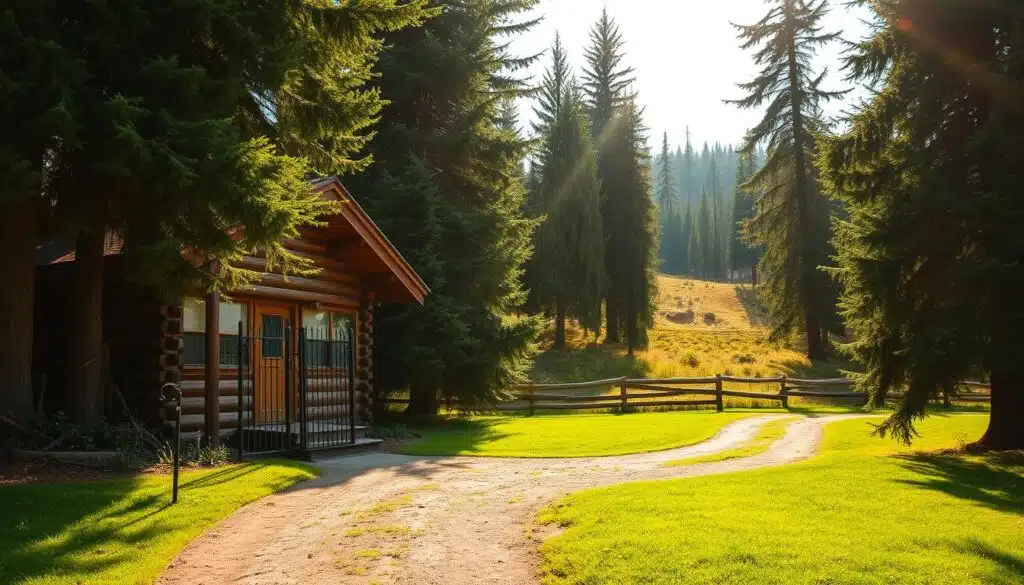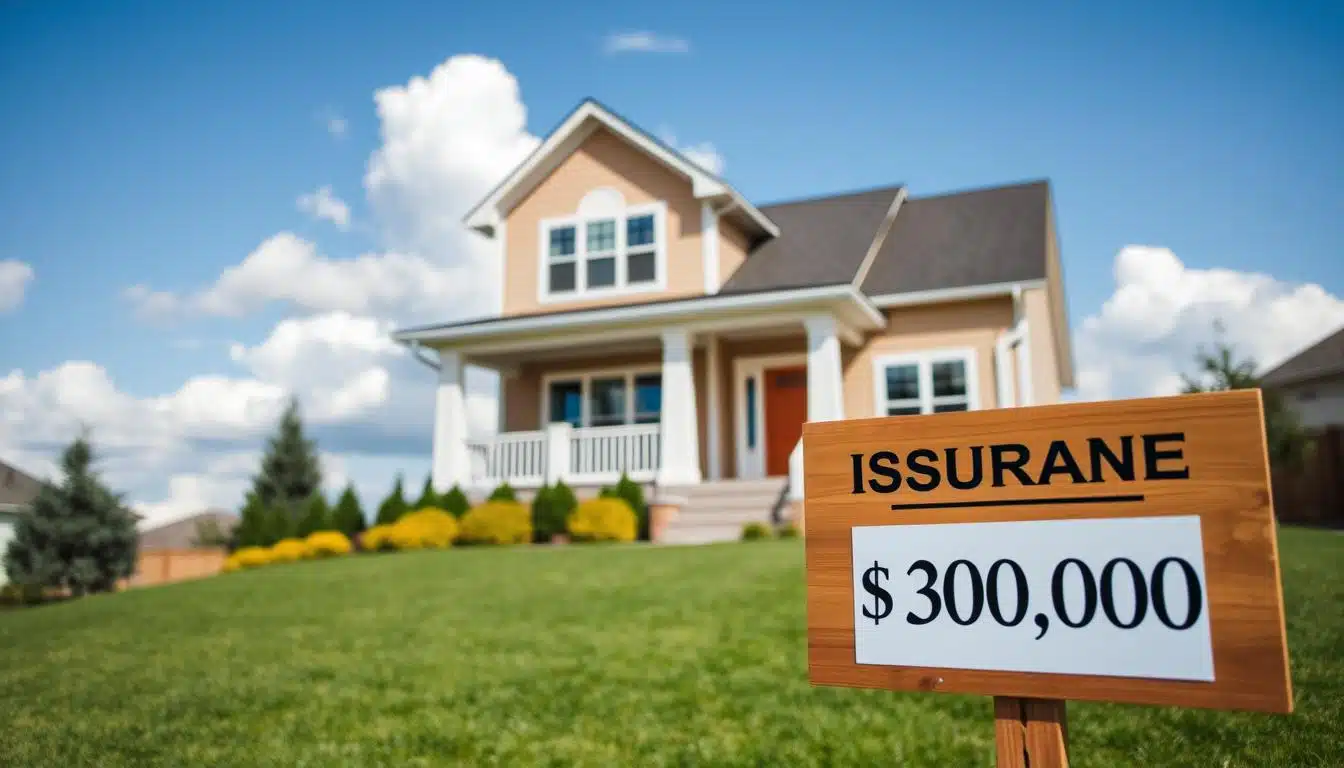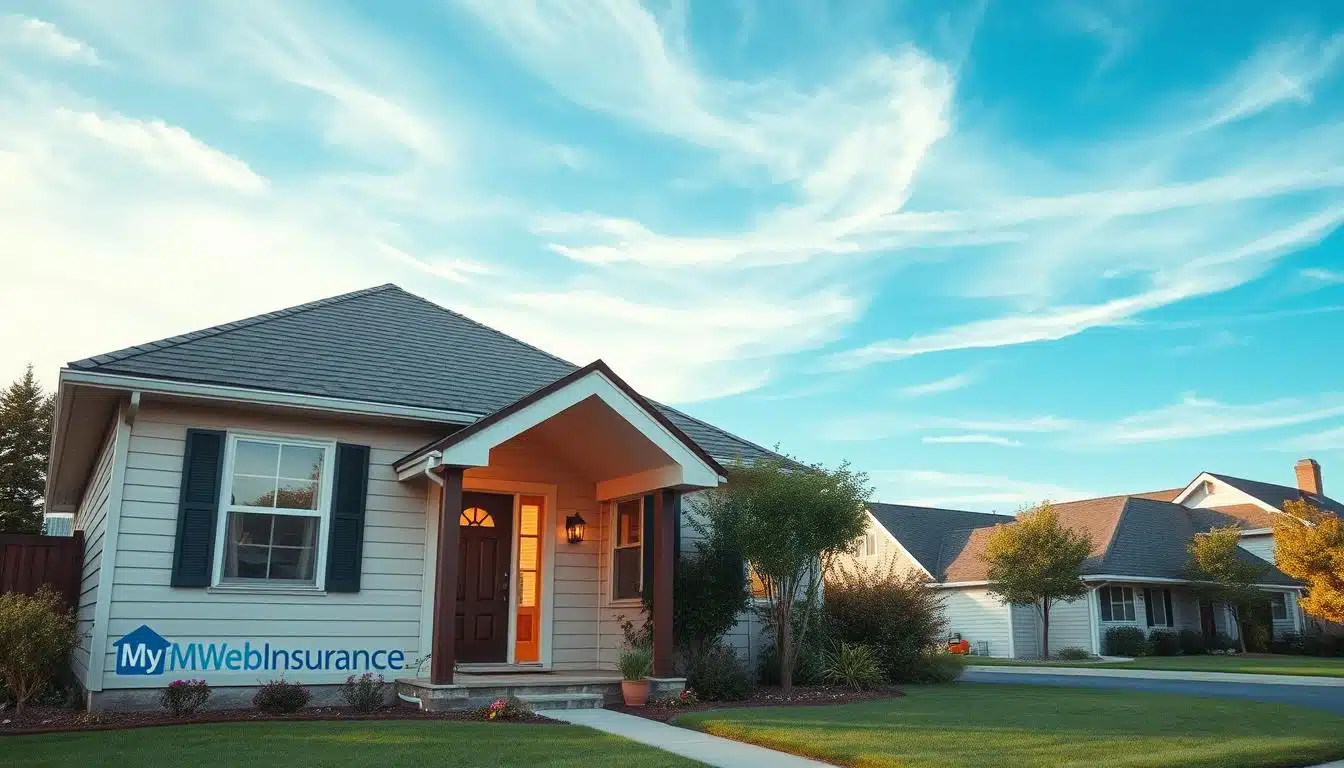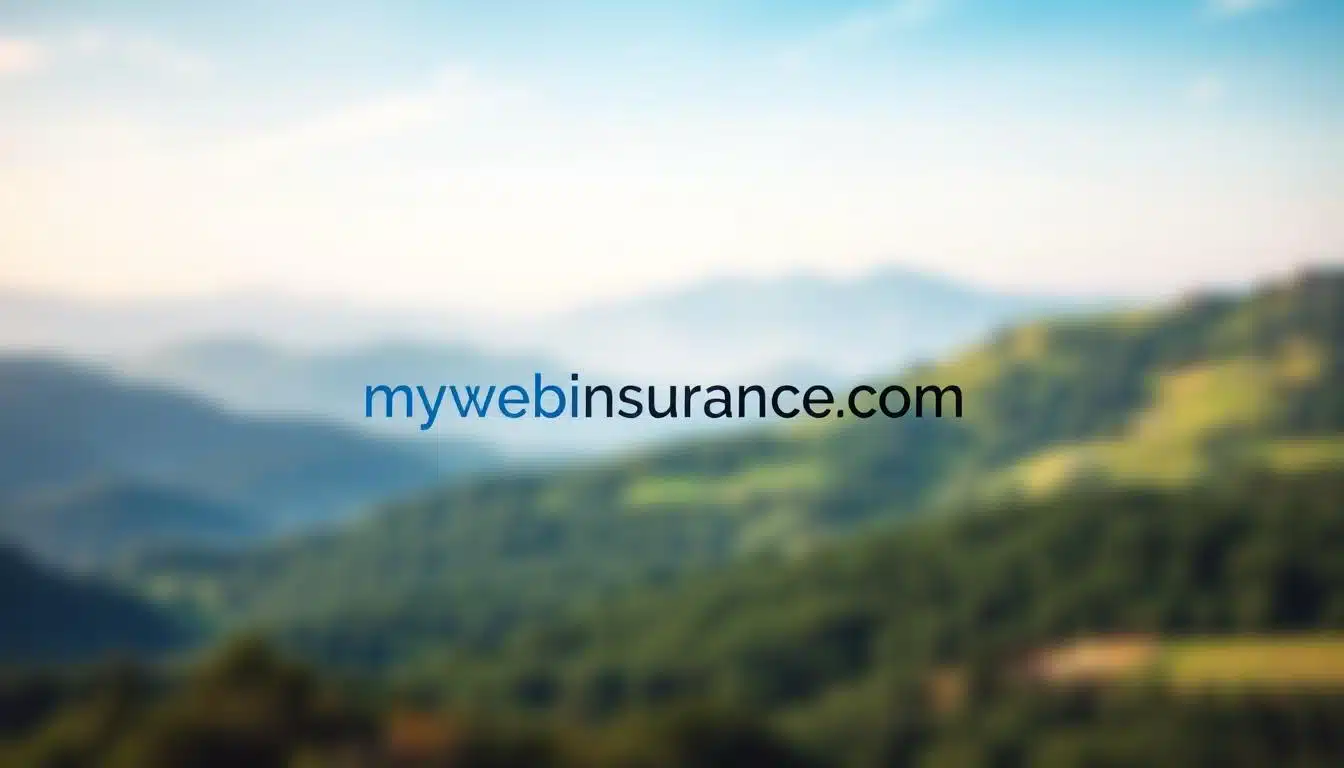Home insurance for log cabins in rural areas safeguards against wildfires, structural vulnerabilities, and remote location risks through specialized policies covering log-specific repairs, debris removal, and regional hazard adjustments excluded in standard homeowners insurance.
Many woodland cabin owners don’t have enough insurance. This leaves them at risk from rising climate dangers. Wildfires now burn twice as much forest area annually than 20 years ago. Extreme weather also weakens old buildings in remote places.
When a storm hits or a wildfire spreads, standard insurance often isn’t enough. It can’t cover the damage.
Rural homes face special problems. FEMA says it takes over 45 minutes to get help in remote spots. Non-traditional materials like logs need special fixing skills.
Modern insurers use maps to check risks like fire danger or floods. This affects how much you pay and what you’re covered for.
Does your insurance cover wildfires that spread to your land? Or what if lumber prices go up after a disaster? These are big gaps in usual policies. That’s why you need rural property insurance that fits your needs.
Table of Contents
ToggleKey Notes;
- Over half of woodland cabin owners risk financial ruin from underinsurance
- 2025 wildfire forecasts predict longer, more intense fire seasons
- Geospatial risk analysis now determines coverage eligibility and costs
- Specialized policies cover debris removal and rare material replacement
- Local response delays heighten need for complete protection
1. Unique Risks Facing Log Cabin Owners in Remote Locations
Log cabins in rural areas face special challenges. Isolation makes environmental threats worse and makes it hard to get help fast. They need special insurance solutions.
Wildfire Vulnerability in Forested Regions
Insurance Services Office (ISO) fire ratings decide if you can get insurance for your cabin. Cedar shake roofs are very risky because they catch fire easily. Now, insurers want Class A fire-rated materials and clear spaces around cabins in danger zones.
Here are some wildfire safety rules:
- Keep a 1,000-gallon water storage cistern
- Clear 30 feet of vegetation around your cabin
- Use spark arrestors on chimneys and vents
Weather-Related Threats to Wooden Structures
Heavy snow and ice can cost $4,200 a year to fix log walls. Moisture intrusion is a big worry for insurers. They often check for sealants every year.
Insurers also worry about flooding. They might not cover cabins in flood areas without special drainage.
Pest Infestation Challenges
Termites cause $650 million in damage to wooden homes each year. Carpenter ants and powderpost beetles can weaken structures. Insurers might not cover damage if they find these pests before you buy insurance.
Most insurers now want:
- Proof of pest control service every quarter
- Inspections with infrared thermal imaging
- Barriers from foundation to roofline
Emergency Service Limitations
Rural fire departments take 14 minutes longer to arrive than city crews. This delay makes fires cost 37% more to fix. Insurers help by:
| Requirement | Urban | Rural |
|---|---|---|
| Fire hydrant proximity | Within 500 ft | On-site water storage |
| Road accessibility | Paved roads | All-weather access |
| Security systems | Optional | Mandatory motion sensors |
These special rules help make insurance work for remote cabins. Make sure your policy fits the current ISO zone and local building codes.
2. How Insurers Assess Log Cabin Insurance Premiums
Insurance companies have special ways to figure out how much to charge for log homes. They look at how the home is built, if it’s ready for fires, and the danger in the area. Let’s see how these things affect your insurance cost.
Material Considerations for Wooden Structures
The size of the logs matters a lot. Big logs (8+ inches) can get you 5-12% off your premium because they last longer and keep warm better. Insurers check:
- Wood treatment certifications
- Roofing material classifications
- Foundation type (pier vs. concrete slab)
Homes with metal or slate roofs get 18-22% off their premium. Your CLUE report is also important. One claim can raise your rates by 9% for five years.
Proximity to Fire Mitigation Resources
Being close to fire stations and hydrants changes how much you pay. Insurers use CalFire’s 2024 models to figure this out:
| Fire Station Distance | Hydrant Availability | Premium Impact |
|---|---|---|
| Within 5 miles | Public hydrant access | Base rate |
| 5-10 miles | Private water storage | +14% |
| 10+ miles | No verified water source | +27% |
Cabins with good space around them and spark-resistant vents can lower your premium by 35%.
Regional Hazard Scoring Systems
Insurers use three types of data to make risk scores for your property:
- Historical wildfire frequency (CAL FIRE Zone maps)
- Floodplain elevation data
- Windstorm exposure ratings
Mountain cabins in High Hazard Zones (HHZ) pay 2.3x more than those in Moderate zones. Upgrades like ember-resistant gutters can boost your score by 15 points.
“A cabin’s ZIP code often matters more than its square footage in premium calculations. Geographic risk modeling drives 60% of base rate decisions.”
National Rural Insurance Association, 2023 Report
How Home Insurance for Log Cabins in Rural Areas Safeguards Your Investment
| Risk/Challenge | Insurance Solution | Safeguard Mechanism |
| Wildfire Vulnerability | Specialized wildfire endorsements | Covers ember damage, funds firebreaks (30ft cleared space), and requires Class A fire-rated materials (e.g., metal roofs). |
| Weather Threats | Snow load/moisture damage coverage | Mandates annual sealant inspections, drainage systems, and storm-resistant upgrades (e.g., impact-resistant roofing). |
| Pest Infestation | Pest damage riders | Requires quarterly pest control contracts and infrared thermal inspections to prevent termite/carpenter ant damage. |
| Emergency Response Delays | Extended repair timelines coverage | Compensates for remote location delays (e.g., 45+ minute FEMA response) by covering temporary lodging and on-site water storage (1,000-gallon cisterns). |
| Underestimated Rebuild Costs | Guaranteed Replacement Cost (125–200% coverage) | Accounts for log-specific rebuild costs (220–280/sqftvs.standard220–280/sqftvs.standard150/sq ft) and rare material sourcing. |
| Material Scarcity | Rare material replacement coverage | Covers custom-milled logs or reclaimed timber, avoiding policy depreciation penalties for authentic repairs. |
| Seasonal Vacancy Risks | Vacant property endorsements | Requires winterization proof (drained pipes, rodent-proofing) and bi-weekly security checks for unoccupied cabins. |
| Regional Hazards | Flood/avalanche/landslide riders | Adjusts coverage based on geospatial risk mapping (e.g., NFIP flood insurance for coastal zones, avalanche protections in Rockies). |
| Climate Change Impacts | Annual policy reviews | Updates coverage using 2025 wildfire forecasts and CAL FIRE zone maps to reflect intensifying risks. |
| Technological & Environmental | Drone assessments + green rebuild discounts | Offers 12–15% premium discounts for LEED-certified rebuilds and uses 3D drone scans to identify hidden structural risks. |
3. Specialized Coverage vs Standard Home Insurance
Log cabins need special insurance because of their unique build and rural spots. Standard home insurance often doesn’t cover timber homes well. This leaves owners at risk for unexpected problems. Let’s look at why log cabin coverage is key for good protection.
3.1 Limitations of Conventional Policies
Big home insurance companies like Allstate often don’t cover important log cabin risks:
- Wood rot exclusion: 78% of standard policies don’t cover moisture damage in untreated logs
- Pest damage caps: Claims for termite/rodent damage are usually capped at $1,500-$3,000
- Rebuild cost underestimation: Policies usually say rebuild costs are $150/sq ft, but real costs are $220-$280/sq ft
3.2 Essential Log Cabin Endorsements
Specialized insurers like Foremost offer special add-ons for timber homes:
- Extended replacement cost coverage – Covers 125-150% of dwelling limit for real log rebuilds
- Ordinance/law protection – Pays up to $50,000 for code upgrades during historic cabin repairs
- Specialized peril riders – Includes wildfire ember damage and snow load collapse
3.3 Policy Features Breakdown
| Coverage Feature | Standard Policy | Log Home Package |
|---|---|---|
| Perils Covered | 16 basic risks | 24+ customized risks |
| Maximum Payout | Dwelling limit | 125% of limit |
| Deductible Options | $1,000-$2,500 | $500-$5,000 |
| Wood Damage | Excluded | Full coverage |
Foremost’s special packages cost 18-22% more than standard ones. But they offer 3x more in claim payouts for log-specific damages. Always check if your coverage includes these key areas:
- Authentic material replacement
- Local contractor availability
- Seasonal vacancy provisions
4. Real-World Claim Scenarios for Rural Cabins

Knowing how insurance handles real disasters is key for cabin owners. We look at three big incidents. They show how insurance works for remote homes.
4.1 Wildfire Restoration Case Study
A family in Colorado lost their 50-year-old cabin in the Hayden Pass Fire of 2020. State Farm’s deal shows two important points:
- Depreciation calculations: Old logs were only worth 40% of their original value
- Rebuild requirements: New laws said the cabin had to be made with fire-safe materials
The rebuild cost was $287,000, but the policy only covered $205,000. This shows why it’s smart to:
- Get replacement cost endorsements
- Update appraisals every 3 years
4.2 Storm-Related Tree Damage Claim
In 2021, a big ice storm in Michigan knocked down a 90-foot pine on a cabin. The claim process shows the challenges of rural areas:
| Phase | Urban Average | Rural Reality |
|---|---|---|
| Adjuster Visit | 3 days | 11 days |
| Payment Release | 14 days | 29 days |
People in the area helped by sending drone videos and contractor quotes right after the storm.
4.3 Vandalism in Seasonal Properties
A Montana hunting cabin was hit by thieves in winter, causing $18,000 in damage. The insurance company cut the payment by 60% because of:
- Missing monthly checks
- Not having motion sensors as the policy asked
This example shows why it’s vital to know about vacant property clauses before getting cabin insurance quotes. Most policies need:
- Security checks every two weeks
- Systems to check the temperature
- Contracts with third-party maintenance
5. Selecting Insurers with Log Home Expertise
Finding the right insurance for your rural cabin is important. Most standard providers don’t know about log homes. Look for insurers who know about log homes and rural risks. They offer special coverage for things like wood damage and wildfires.
5.1 Carrier Specialization Criteria
Choose insurers with these four things:
- AM Best financial strength rating of A- or higher
- Dedicated log home insurance programs
- Regional offices within your state
- Guaranteed replacement cost coverage
Top insurers like Farmers, Nationwide, and Chubb have teams for log homes. Travelers Insurance has rural-specific guidelines for seasonal homes and preserving wood. Make sure their policies cover:
| Insurer | AM Best Rating | Log Home Program | Replacement Cost Rider |
|---|---|---|---|
| Farmers | A | Yes | 125% |
| Nationwide | A+ | Yes | 150% |
| Chubb | AA | Yes | 200% |
5.2 Interview Questions for rural home insurance Providers
Ask these important questions:
- How do you adjust coverage for hand-hewn timber vs milled logs?
- What documentation proves maintenance of wood preservatives?
- Do you waive deductibles for wildfire mitigation upgrades?
Ask for examples of rural home insurance claims for log homes. Good providers will talk about getting special materials and working with local contractors. Stay away from companies without references from other cabin owners.
“Guaranteed replacement cost riders are non-negotiable for log homes. Standard policies often undervalue custom timber work.”
Travelers Underwriting Guidelines
Choose based on how fast they handle rural claims and if they have 24/7 emergency services. Specialized insurers handle log cabin claims 40% faster than others, data shows.
6. Premium Reduction Strategies for Cabin Owners

Owners of rural log cabins can save a lot on insurance. They can do this by managing risks well. Two ways to do this are by improving safety features and keeping up with maintenance.
6.1 Protective Infrastructure Investments
Modern safety systems can cut premiums by 15-35%. Here are some key upgrades:
- Wildfire sprinkler systems (22% average premium reduction)
- UL-certified security systems with cellular backup
- Lightning-resistant electrical panels
- Impact-resistant roofing materials
Installing fire-resistant gutters or creating a safe area around your cabin can get you discounts. One company saw 18% fewer claims in cabins with gravel firebreaks.
6.2 Maintenance Documentation Practices
Keeping good records shows you manage risks well. Use this checklist every year:
- Roof inspection photos (spring and fall)
- Pest control service receipts
- Chimney cleaning certifications
- Tree trimming documentation
Apps from insurance providers make keeping records easier. A 2023 study found claims were 40% faster with recent photos. Keep your records in the cloud with these folders:
| Folder Type | Documents to Include | Retention Period |
|---|---|---|
| Structural | Foundation inspections, roof repairs | 7 years |
| Systems | HVAC servicing, electrical updates | 5 years |
| Landscape | Tree removal permits, firebreak maps | 3 years |
Using these methods together can save a lot. One cabin owner in Colorado saved $614 a year. They installed storm shutters and shared 5 years of maintenance records.
7. Seasonal Occupancy Insurance Considerations
Owning a rural log cabin can be tricky because of seasonal use. Most policies don’t cover empty homes well. That’s why rural dwelling endorsements are key for owners who leave their cabins for long times.
Insurers like Erie and American Family have different rules for empty homes. Erie wants proof of winterization after 30 days. American Family gives a 60-day break.
7.1 Winterization Requirements
Insurers have strict rules for keeping cabins safe during the cold. Not following these rules can mean no insurance for damage from freezing. Here are the main things they want:
- Draining water systems with compressed air
- Putting in heating cables that turn on when it’s cold
- Keeping rodents out with steel wool and metal mesh
- Checking and closing the chimney damper
Erie Insurance wants proof of these steps, like photos or receipts. American Family lets you say you’ve done it yourself but needs you to check in every year.
7.2 Vacation Rental Coverage Options
Using your cabin for Airbnb rentals adds risks that regular policies don’t cover. Berkshire Hathaway points out three big gaps in coverage:
“Renting out short-term makes 78% of home policies not cover business use. You need special business liability coverage if you rent out more than 14 days a year.”
Special endorsements are needed for:
- Liability for guest injuries up to $1 million
- Protection for guests’ stolen items
- Help with disputes over damage
Farmers Insurance and Nationwide now have policies for both vacation rentals and homes. But, these cost 18-22% more than usual policies.
8. Regional Hazard Adjustments for Coverage
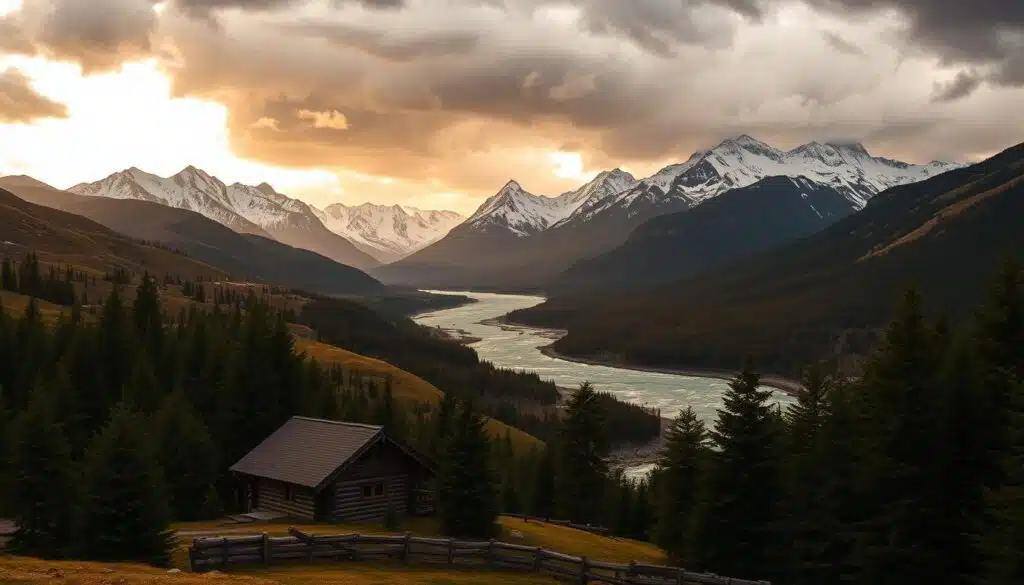
Insurance needs for log cabins change a lot based on where they are. Insurers make special policies for places with big risks. This helps keep remote property insurance costs down.
Mountainous Terrain Provisions
Cabins in high places have special problems. USAA has special coverage for avalanches in Rocky Mountains. Liberty Mutual gives up to 12% premium credits for things like walls or drains.
Landslide protection changes a lot by area:
- Pacific Northwest policies often include debris flow riders
- Appalachian Mountain coverage typically requires separate endorsements
- Colorado insurers mandate avalanche zone disclosures
Coastal Area Protections
Coastal cabin owners face strict rules for flood insurance. Properties in flood zones need special certificates. Insurers know the difference between:
- Gulf Coast hurricane exposure
- New England nor’easter risks
- Pacific Northwest tsunami zones
Some companies like Farmers Insurance have special packages for beach homes. Critical: Coastal policies often don’t cover mold damage from storms unless you add an extra part.
9. Emerging Trends in Rural Property Insurance
The insurance world is changing to meet the needs of remote areas. Now, home insurance for log cabins in rural areas uses new tech and green solutions. These changes help protect homes better and care for the environment.
9.1 Drone-Based Risk Assessment
Companies like Nationwide use drones to check log cabin risks faster. These drones fly over properties to make 3D models. They spot:
- Roof problems you can’t see from the ground
- Hidden pest damage in hard spots
- How close trees are to buildings
A 2023 study found drones cut down underwriting time by 40% for Colorado cabins. They also help make plans to fight wildfires with up-to-date data.
| Assessment Method | Time Required | Data Points Collected |
|---|---|---|
| Manual Inspection | 4-6 hours | 85 |
| Drone Survey | 45 minutes | 1,200+ |
9.2 Green Rebuilding Options
Insurers now give discounts for eco-friendly rebuilds. After a Montana wildfire in 2022, Timber Ridge Mutual offered:
- 15% off premiums for LEED-certified rebuilds
- Carbon credits for green materials
- More coverage for solar panels
Here’s a table comparing costs for rebuilding with and without green options:
| Material Type | Average Cost/Sq Ft | Insurance Discount |
|---|---|---|
| Traditional Lumber | $185 | 0% |
| Reclaimed Wood | $210 | 8% |
| Fire-Resistant Composite | $245 | 12% |
These new steps help save money and protect nature. “Green upgrades pay for themselves through insurance savings within 7-10 years,” says a Timber Ridge claims adjuster.
10. Conclusion
Owners of rural log cabins face special challenges. They need special insurance solutions. This guide showed how to protect wooden homes from fires, weather, and other rural dangers.
First, ask for a CLUE report review to find coverage gaps. Then, call Farm Bureau Insurance for a custom cost estimate. Make sure to install UL-rated smoke detectors in your home.
Check out State Farm’s log home application to find the best policy. Also, visit FEMA’s wildfire guide for new ways to stay safe. These steps help when you’re far from help.
Check your insurance every year because dangers can change. Insurers use drones and green rebuilding now. Make sure your policy is up to date.
Log cabin insurance needs careful attention. Use expert advice and practical steps to keep your home safe and valuable for many years.
FAQ
Why do log cabins require specialized insurance policies?
Log cabins face risks like ember ignition and wood rot. These risks aren’t covered by standard home insurance. Specialized policies offer extended replacement costs and debris removal in remote areas.
How do insurers calculate premiums for rural log cabins?
Insurers look at geospatial risk mapping and log diameter. They also check ISO fire ratings. Nationwide uses drones to assess roofs, which can lower premiums.
What coverage gaps exist in standard home insurance for cabins?
Standard policies often exclude vacant property vandalism and wood deterioration. Foremost’s log home package covers these and more. Always check water cistern requirements.
How do wildfire prevention measures affect insurance costs?
Installing UL-rated exterior sprinklers can lower premiums. State Farm offers discounts for Firewise USA-certified properties. Colorado’s 2023 wildfire showed cabins with ember-resistant vents had less damage.
What special considerations apply to seasonal log cabins?
Erie Insurance requires winterization proof for vacant cabins. American Family mandates bi-weekly inspections during closure. For Airbnb rentals, Berkshire Hathaway requires commercial liability endorsements.
How do regional hazards impact log cabin coverage?
USAA’s avalanche coverage in Rocky Mountain states adds $148/year. Coastal cabins need NFIP flood insurance and storm surge riders. Chubb’s policies cover saltwater corrosion damage excluded in standard forms.
What documentation strengthens insurance claims for log cabins?
Keep annual inspection reports and timestamped photos of log condition. Include material receipts. In Montana’s 2023 LEED-certified cabin fire, Farmers paid more for certified sustainable wood.
Which insurers specialize in log cabin coverage?
AM Best-rated options include Nationwide, Farmers, and Chubb. Ask providers about timber framing expertise and hand-hewn log valuation. Travelers requires 5-year resealing records for stain warranties.
How does cabin maintenance affect insurance eligibility?
A> 92% of denied claims relate to preventable deterioration. Follow this checklist: Biannual pest inspections, 5-year chinking replacement, and immediate storm debris removal. State Farm reduces premiums 12% for cabins with automated moisture sensors and cellular-connected smoke detectors.
What emerging technologies impact log cabin insurance?
Nationwide’s drone inspection program cuts underwriting time 40% using AI. Timber Ridge Mutual offers carbon credit bonuses for sustainable rebuilds. Always request 3D structure scans during policy renewal.

